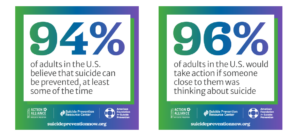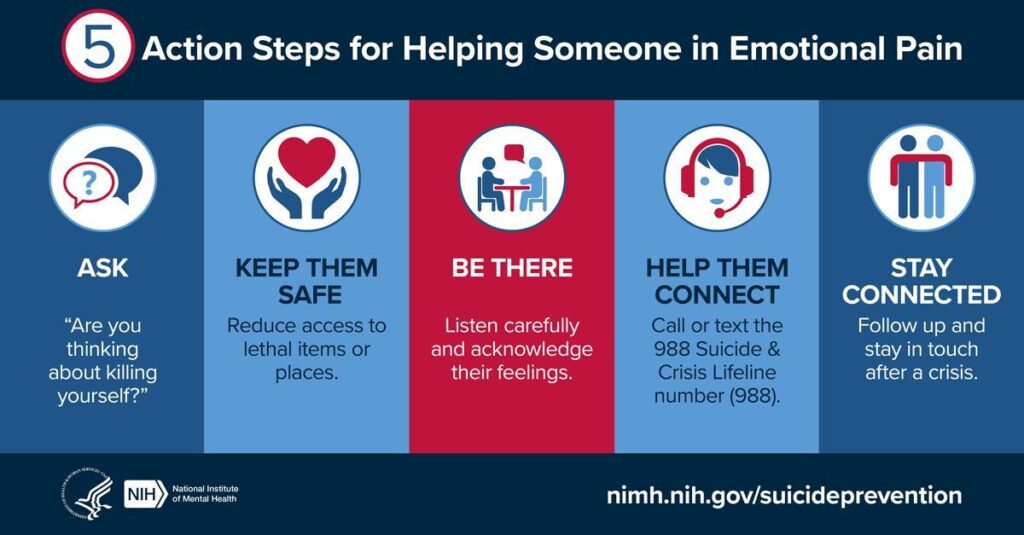May is Mental Health Awareness Month; however, raising awareness of mental health and mental illness should occur every day. Mental health and suicide prevention are topics that should be discussed thoroughly, especially in schools. Based on the latest data by the World Health Organization (WHO), suicide is ranked as one of the highest causes of death in the world.1 Youth and young adults are at an increased risk of dying by suicide considering that ages 10–24 years accounted for 15% of all suicides in 2021. Many reasons give rise to mental health issues and the probability of suicide.2 For instance, bullying, stressful life events or loss, family problems, and depression frequently cause students to feel hopeless and lonely. The good news is that we can prevent suicide in a multitude of ways! Each of us—students, faculty, and administration—plays an important role in encouraging mental health awareness and suicide prevention.
Increasing awareness, educating on the importance of mental health, recognizing signs and symptoms of poor mental health, and providing support for one another can foster a space where students are mentally protected, feel encouraged, and empowered to take on the challenges in life. No effort is too small and you can end up making a significant difference in a student’s life. Examples of intervening include reporting indicators such as abrupt behavioral changes, aggression, acting hopeless or students discussing suicide, calling absentee students, and connecting to resources.3 It is critical that students understand that they may talk freely and judgment-free about their mental health to a trusted adult. It is also important to refrain from stigmatizing students, grant mental health days, and emphasize the equal importance of mental and physical well-being.4
It is important to note that timely utilization of appropriate resources and support systems can aid in suicide prevention efforts. Coordination and collaboration between students, school staff, families, and community health services are important for early intervention. Peer support initiatives can also assist students in supporting one another during trying times. School counselors, teachers, and social workers can provide support and crisis intervention as needed. Medical professionals, therapists, counselors, and other experts can offer vital support through medicine, therapy, counseling, or other forms of treatment.5 Public awareness and training can empower all individuals to recognize warning signs and seek help when concerned about themselves or others. Other resources available to the community include:
- 988 Suicide & Crisis Lifeline: Available 24 hours. Dial 988 or call the NJ Suicide Prevention Hopeline at 1-855-654-6735. Visit: www.njhopeline.com 6.
- 2NDFLOOR: A confidential and anonymous helpline for NJ youth and young adults. Call or text 1-888-222-2228. Visit www.2ndfloor.org
- The National Suicide Prevention Lifeline: A toll-free line that operates continually at 1-800-273-8255, should be referred if suicidal ideation is suspected.5
- The Crisis Text Line: Dial or text ‘HOME’ to 74174. Visit: www.crisistextline.org/text-us/
- If there is imminent danger, call 911.
 Addressing mental health and suicide prevention in schools requires a multi-faceted approach that involves everyone in the educational community. By fostering a culture of openness and support, providing access to resources and professional help, and implementing preventive measures, schools can become safer and more supportive environments for students. It is crucial for educators, students, and families to work together, recognize warning signs, and take proactive steps to promote mental well-being. Through these efforts, we can make schools places where students feel protected, supported, and empowered, ultimately saving lives and building healthier communities.
Addressing mental health and suicide prevention in schools requires a multi-faceted approach that involves everyone in the educational community. By fostering a culture of openness and support, providing access to resources and professional help, and implementing preventive measures, schools can become safer and more supportive environments for students. It is crucial for educators, students, and families to work together, recognize warning signs, and take proactive steps to promote mental well-being. Through these efforts, we can make schools places where students feel protected, supported, and empowered, ultimately saving lives and building healthier communities.
References
- Suicide Prevention Resource Center. (n.d.). A Comprehensive Approach to Suicide Prevention. https://sprc.org/effective-prevention/comprehensive-approach.
- Centers for Disease Control & Prevention. (2023, May 9). Disparities in Suicide. https://www.cdc.gov/suicide/facts/disparities-in-suicide.html.
- Suicide Prevention Resource Center. (2023, August 18). Be the Change: How to Support Suicide Prevention Efforts This September. https://sprc.org/news/be-the-change-how-to-support-suicide-prevention-efforts-this-september/.
- Mental Health America. (n.d.). Suicide Prevention. https://mhanational.org/suicide-prevention.
- Substance Abuse and Mental Health Services Administration. (2023, April 24). 988 Suicide & Crisis Lifeline. https://www.samhsa.gov/find-help/988.
- Mental Health Foundation. (n.d.). Suicide Prevention. https://www.mentalhealth.org.uk/our-work/public-engagement/suicide-prevention.
- Substance Abuse and Mental Health Services Administration. (n.d.). 988 Suicide & Crisis Lifeline. https://988lifeline.org/.







